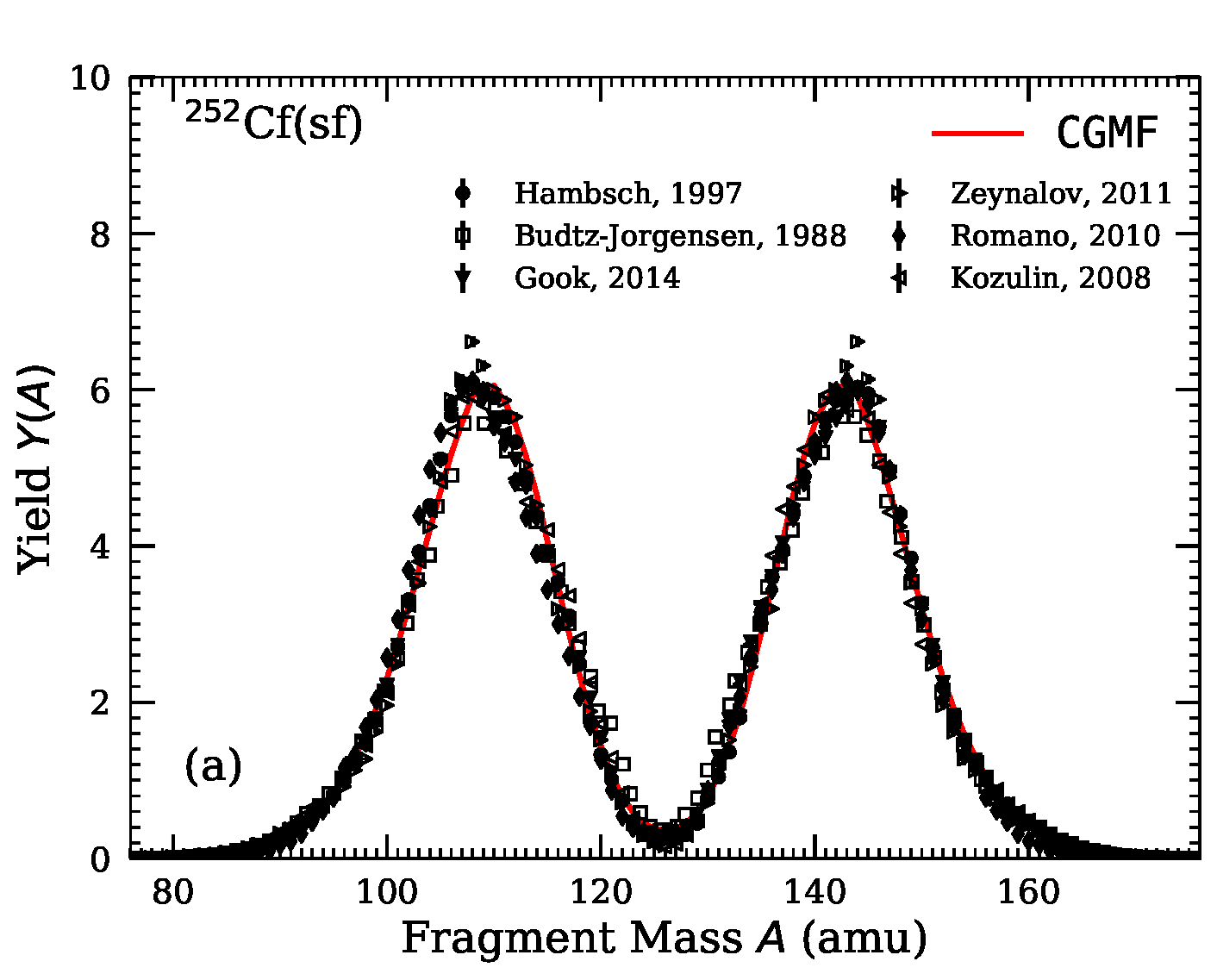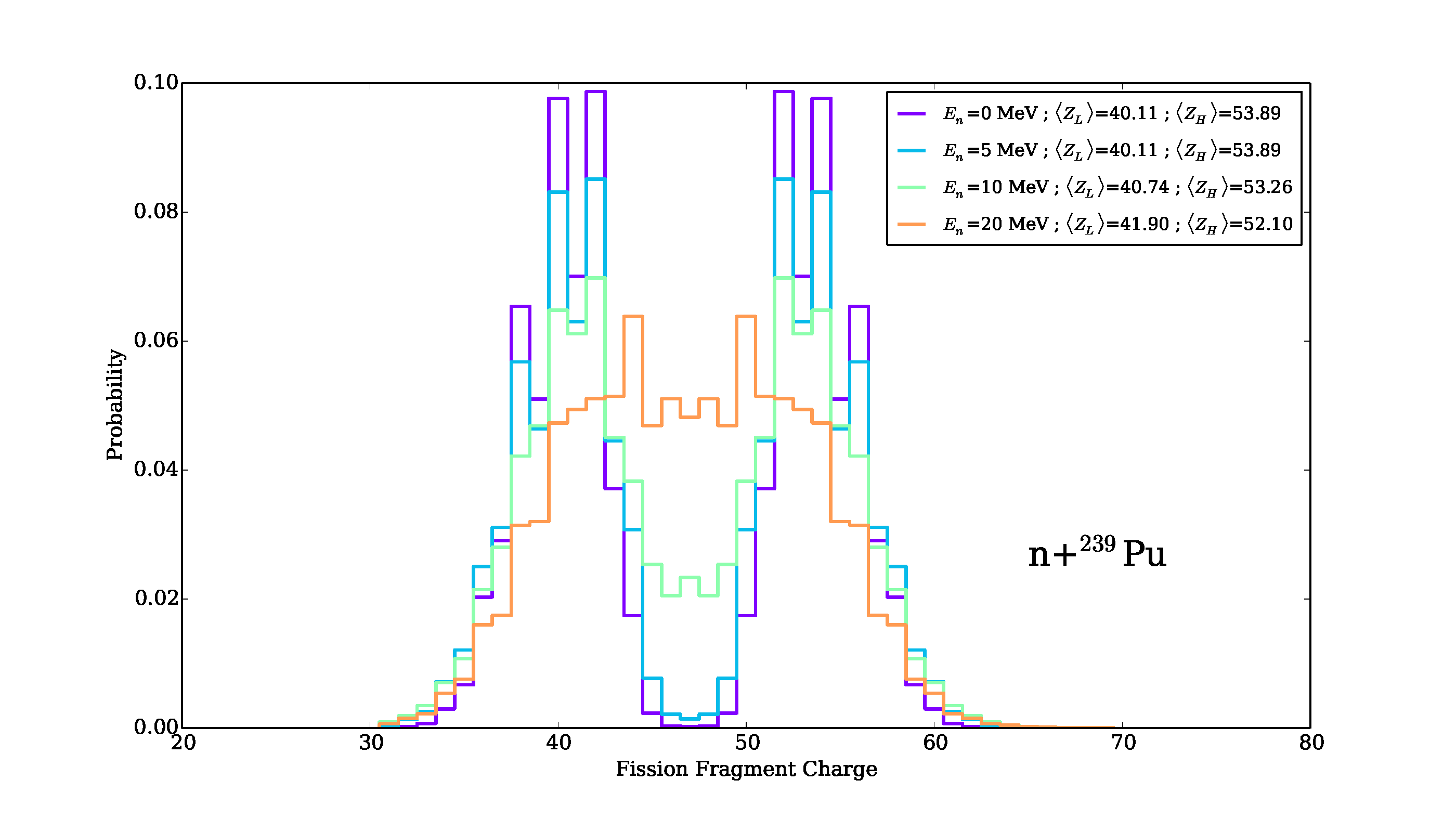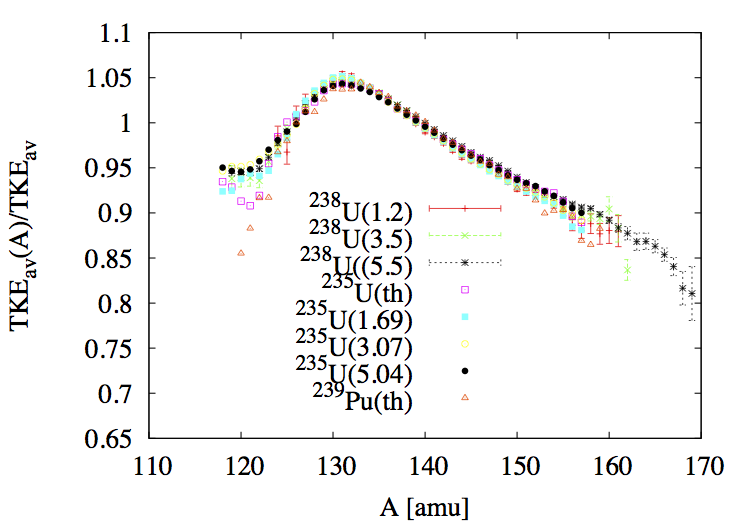Fission Fragment Yields¶
CGMF does not calculate the initial pre-neutron fission fragment yields. Instead, it reads or reconstructs those yields in mass, charge and kinetic energy, \(Y(A,Z,TKE)\), from experimental data or systematics. Several theoretical efforts are underway to predict fission fragment yields from dynamical fission calculations. We will incorporate the results of those works as they become available and more accurate.
In the present version of CGMF, only binary fission events are considered. Ternary fission in which an \(\alpha\) particle is emitted along with the two fragments is not treated, nor more complicated “fission” splitting, e.g., accompanied with cluster emission. In addition, the neutron emission is assumed to happen only once both fragments are fully accelerated. In other words, no scission neutrons are considered at this point. However, multi-chance fission processes such as (\(n,n'f\)), (\(n,2nf\)), etc., as well as pre-equilibrium neutron emissions are taken into account at higher incident energies.
Systematics of scission fragment yields, i.e., right after scission but before any neutron emission, in mass, charge and kinetic energy, \(Y(A,Z,TKE)\), have been developed for CGMF. They are reconstructed from partial, one-dimensional distributions.
Note
In release 1.1.0, the following fission fragment yields have been developed:
- Spontaneous fission reactions of Pu-238,240,242,244 and Cf-252,254.
- Neutron-induced fission reactions from thermal up to 20 MeV for: n+U-233,234,235,238 and n+Pu-239,241.
Mass Yields¶
By default, CGMF implements a three-Gaussian model to represent pre-neutron fission fragment mass distributions, as follows:
where \(G_0\) corresponds to a symmetric mode,
and \(G_1\) and :math`G_2` are the two asymmetric modes
Here, \(\overline{A}=A_p/2\), with \(A_p\) the mass of the parent fissioning nucleus, which can differ from the original compound nucleus \((Z_c,A_c)\) if pre-fission neutrons are emitted. The parameters \(\mu_i\) are the means, \(W_i\) are the weights, and \(\sigma_i\) are the widths of the Gaussian modes. In the case of pre-fission neutron emission, the parameters are chosen for the resulting parent fissioning nucleus (i.e. \(A_p=A_0-\nu_\mathrm{pre}\)).
Fragment mass yields depend on the incident neutron energy, and this is reflected in the means, widths and weights of the Gaussian modes as follows:
and
The weight of the symmetric Gaussian \(W_0\) is inferred by normalizing the integrated distribution to 2.0 as: \(W_0 = 2 - 2W_1 - 2W_2\).
The fission fragment mass yields obtained for Cf-252(sf) and for U-235(n,f) are shown in Figs. (1) and (2).
Charge Yields¶
The charge distributions as function of fragment mass and incident neutron energy follow Gaussian forms according to Wahl’s systematics (Wahl:2002). The means are given by the unchanged charge distribution (UCD) corrected for the observed charge polarization. The widths are a function of the fragment mass, fitted to available experimental data as a function of energy. Shell effects, and their gradual vanishing as a function of excitation energy, are included as a function of fragment mass, fissioning nucleus, and incident neutron energy. The full description of Y(Z;A,En) can be found in Ref. (Wahl:2002).
An example of the resulting total charge yield distribution Y(Z) is shown in Fig. (3) for the thermal neutron-induced fission of U-235.
Charge Yields¶
Warning
Obsolete?
Wahl systematics (Wahl, 2002) are then used to obtain the charge distribution for a given mass following:
where
and \(erf(x)\) represents the error function. The factor \(N(A)\) is simply a normalization factor. The most probable charge is given by
where \(Z_c,A_c\) are the charge and mass of the fissioning compound nucleus, \(\sigma_z\) is the charge width parameter and \(\Delta Z\) is the charge deviation. The odd-even factor \(F(A)\) is computed as
The average charge distribution is obtained by convoluting \(Y(Z|A)\) over the fragment mass distribution \(Y(A)\), and the result is shown in figure fig-YZ-Einc for the heavy fission fragments only.
Total Kinetic Energy (TKE) Distributions¶
The average total kinetic energy \(\overline{TKE}\) is an important quantity that determines in great part the total excitation energy available in the system for the evaporation of neutrons and photons. Since most neutrons are emitted prior to photon emission, the average total prompt neutron multiplicity, \(\overline{\nu}\), strongly depends on an accurate value for \(\overline{TKE}\). For the simulation of single fission events, \(TKE\) distributions have to be known for all fragments.
For thermal neutron-induced fission reactions on important isotopes as well as spontaneous fission, some reliable and rather consistent experimental data exist, albeit less so in the symmetric region where fission events are rare.
To reconstruct the total kinetic energy dependence of the fission fragment yields, one can use experimental information on the average \(TKE\) as a function of the fragment mass \(A\) as well as its width \(\sigma_{TKE}(A)\). Continuing on the example above for thermal neutron-induced fission of Pu-239, we have performed a least-square fit of \(\overline{TKE}(A)\) as seen in Fig. fig-TKEA.

Fig. 5 - Average total kinetic energy as a function of the heavy fragment mass in the case of the thermal neutron-induced fission of Pu-239.
The \(TKE\) distribution for each fragment mass is then reconstructed using
In a first approximation, one can assume that the shape of \(\overline{TKE}(A)\) as well as \(\sigma_{TKE}(A)\) are independent of the particular fissioning system and the energy of the incident neutron (see Fig. fig-TKEA-Isotopes). We therefore assume that only the absolute scaling of \(\overline{TKE}\) changes with energy.
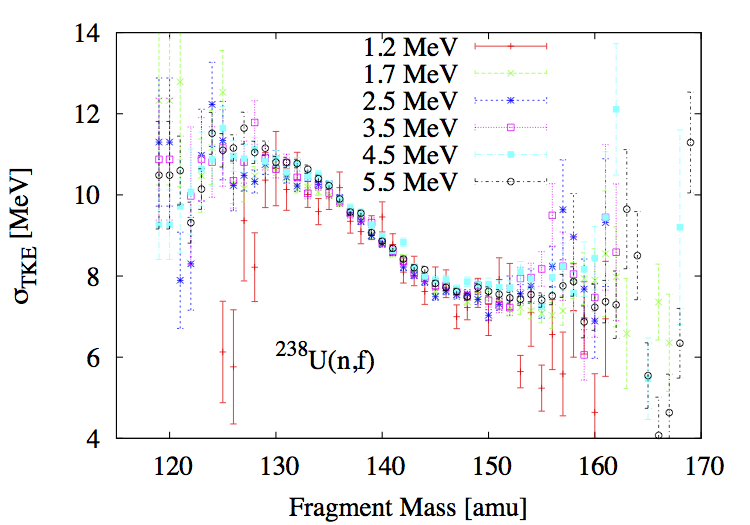
Fig. 7 - Experimental data available for the mass and incident energy dependence of \(\overline{TKE}\) and \(\sigma_{TKE}\) are shown for several fissioning systems and incident neutron energies.
Note
The mass-dependent average total kinetic energy does change with incident energy, reflecting changes in the shell corrections as the excitation energy is increased. A more refined treatment of this quantity will be tackled in the future.
The energy-dependence of \(\overline{TKE}\) is poorly known for most systems. However, recent experimental data have shed some light on this issue. In the current version of the code, we assume that for each pair of fission fragments, \(TKE\) can be represented by a normal distribution \(\mathcal{N}_{(\langle TKE \rangle,\sigma_{TKE})}(A,E_n)\), and assume that the energy dependence is entirely encoded in the average value \(\overline{TKE}\).
In the current code implementation, the mass and energy-dependent distributions \(TKE(A,E_n)\) are obtained as
The energy dependence of \(\overline{TKE}(A)\) is given by the Madland systematics (Madland,2006), which are simple linear or quadratic fits to experimental data for selected isotopes. Making the distinction between the total fission fragment (pre-neutron) kinetic energy, \(TKE_{pre}\), and the total fission product (post-neutron) kinetic energy, \(TKE_{post}\), those systematics read:
For n+U-235,
For n+U-238,
And for n+Pu-239,
Madland’s fits were only constructed up to the threshold for second-chance fission. We assume however that they are valid at higher energies as well for the initial fissioning nucleus. Above the second-chance fission threshold, the average \(TKE\) does not necessarily follow a linear or quadratic behaviour though, as successive neutron emissions modify the fissioning nucleus and its excitation energy. We further assume that Madland’s energy-dependence parameterizations remain valid for the nuclei A-1, A-2, etc. Only the reference thermal value of \(\overline{TKE}(E_{th})\) is changed according to Viola’s systematics (Viola:1985])
Complete \(Y(A,Z,TKE)\) Yields Reconstruction¶
Finally, the full pre-neutron emission fission fragment distributions can be reconstructed as:
The resulting \(Y(A,TKE)\) distribution is shown here:
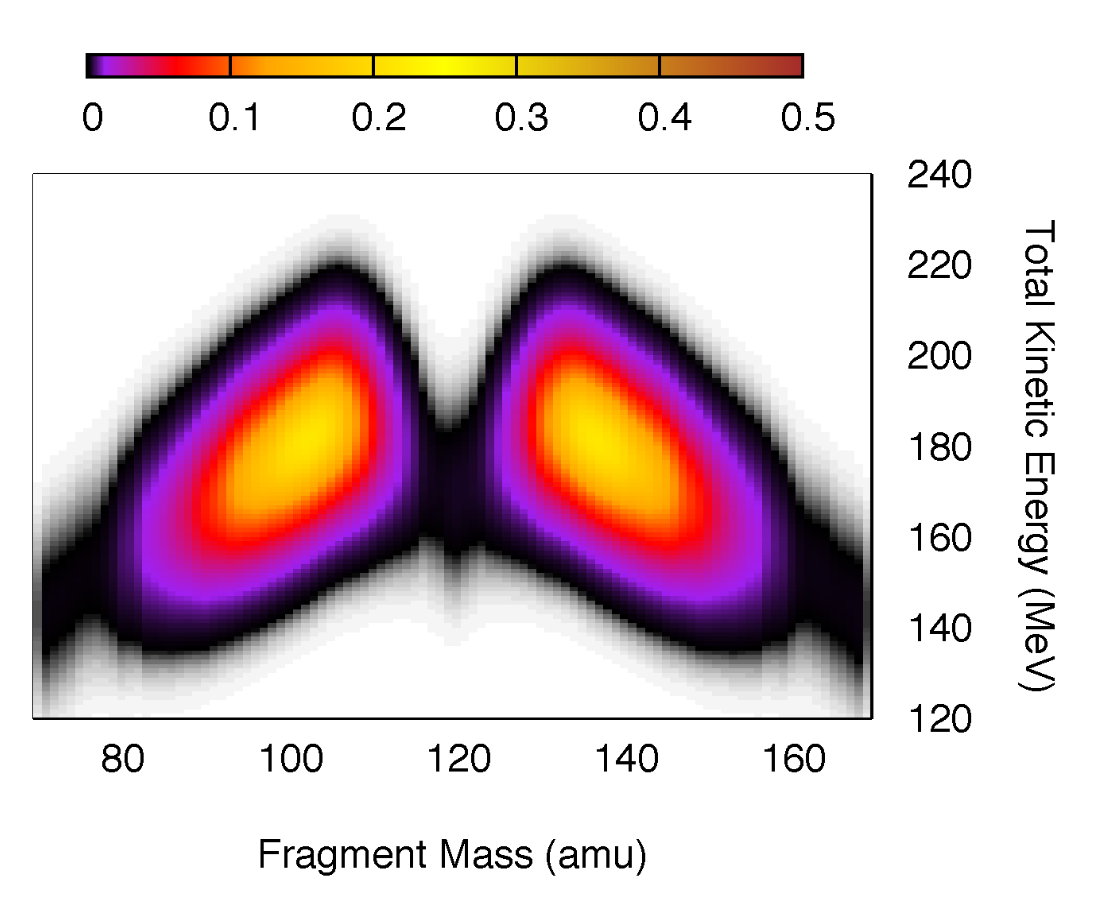
Fig. 9 - Mass and Total Kinetic Energy yields reconstructed using Eq. (5) in the thermal neutron-induced fission of Pu-239.
The approach described above to evaluate the pre-neutron emission fission fragment yields is not unique, and depends on the type of experimental data that have been measured. In some cases, the two-dimensional \(Y(A,TKE)\) distribution has been measured (Romano,2010), and therefore only the charge distribution for every fragmentation has to be computed to obtain the full distribution. In the majority of cases, however, no such information is available and one has to rely on systematics and/or phenomenological models. The present version of CGMF is limited to the few isotopes and reactions that have been well measured. The extension to other isotopes and reactions is planned for the near future.
